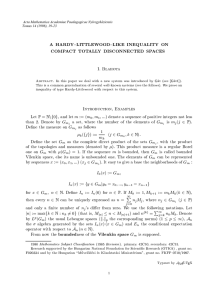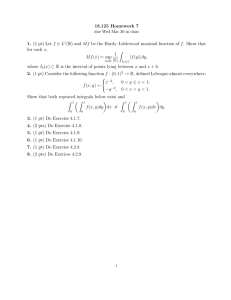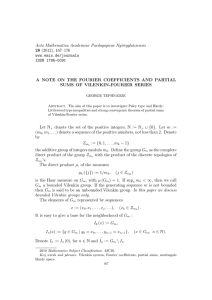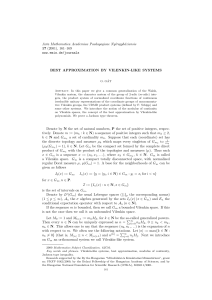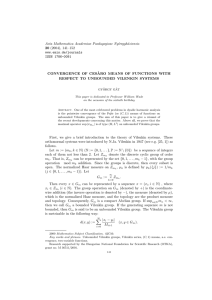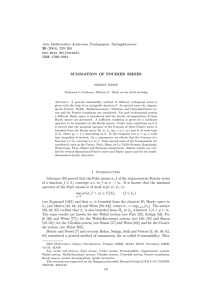A HARDY{LITTLEWOOD{LIKE INEQUALITY ON TWO{DIMENSIONAL COMPACT TOTALLY DISCONNECTED SPACES
advertisement
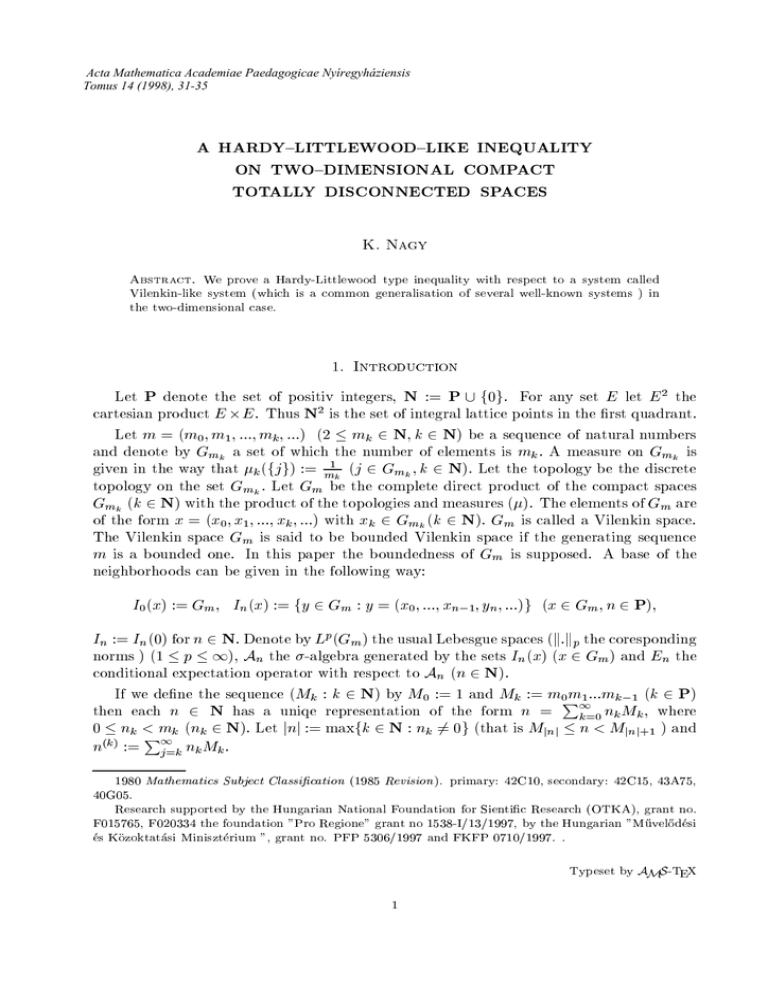
Acta Mathematica Academiae Paedagogicae Nyíregyháziensis
Tomus 14 (1998), 31-35
A HARDY{LITTLEWOOD{LIKE INEQUALITY
ON TWO{DIMENSIONAL COMPACT
TOTALLY DISCONNECTED SPACES
K. Nagy
Abstract. We prove a Hardy-Littlewood type inequality with respect to a system called
Vilenkin-like system (which is a common generalisation of several well-known systems ) in
the two-dimensional case.
1. Introduction
Let P denote the set of positiv integers, N := P [ f0g. For any set E let E 2 the
cartesian product E E . Thus N2 is the set of integral lattice points in the rst quadrant.
Let m = (m0; m1 ; :::; mk ; :::) (2 mk 2 N; k 2 N) be a sequence of natural numbers
and denote by Gmk a set of which the number of elements is mk : A measure on Gmk is
given in the way that k (fj g) := m1k (j 2 Gmk ; k 2 N): Let the topology be the discrete
topology on the set Gmk : Let Gm be the complete direct product of the compact spaces
Gmk (k 2 N) with the product of the topologies and measures (). The elements of Gm are
of the form x = (x0; x1; :::; xk ; :::) with xk 2 Gmk (k 2 N): Gm is called a Vilenkin space.
The Vilenkin space Gm is said to be bounded Vilenkin space if the generating sequence
m is a bounded one. In this paper the boundedness of Gm is supposed. A base of the
neighborhoods can be given in the following way:
I0(x) := Gm ; In (x) := fy 2 Gm : y = (x0 ; :::; xn,1; yn ; :::)g (x 2 Gm ; n 2 P);
In := In (0) for n 2 N: Denote by Lp (Gm ) the usual Lebesgue spaces (k:kp the coresponding
norms ) (1 p 1), An the -algebra generated by the sets In (x) (x 2 Gm ) and En the
conditional expectation operator with respect to An (n 2 N):
If we dene the sequence (Mk : k 2 N) by M0 := 1 and Mk := m0Pm1 :::mk,1 (k 2 P)
then each n 2 N has a uniqe representation of the form n = 1
k=0 nk Mk ; where
0 nk <Pmk (nk 2 N): Let jnj := maxfk 2 N : nk 6= 0g (that is Mjnj n < Mjnj+1 ) and
n(k) := 1
j =k nk Mk .
1980 Mathematics Subject Classication (1985 Revision ). primary: 42C10, secondary: 42C15, 43A75,
40G05.
Research supported by the Hungarian National Foundation for Sientic Research (OTKA), grant no.
F015765, F020334 the foundation "Pro Regione" grant no 1538-I/13/1997, by the Hungarian "M}uvel}odesi
es Kozoktatasi Miniszterium ", grant no. PFP 5306/1997 and FKFP 0710/1997. .
Typeset by AMS-TEX
1
2
K. NAGY
Now, introduce an orthonormal system on Gm called Vilenkin-like system (see [G]).
The complex valued functions rkn : Gm ! C are called generalised Rademacher functions
if the following properties holds:
i. rkn is Ak+1 measurable, rk0 = 1 for all k; n 2 N:
ii. If Mk is a divisor of n; l and nk+1 = lk+1 (n; lk 2 N), then
Ek (rknrkl ) =
1 if n = l
k k
0 if nk 6= lk ;
where z is the complex conjugate of z.
iii. If Mk is a divisor of n (that is n = nk Mk + nk+1 Mk+1 + ::: + njnjMjnj ), then
mX
k ,1
nk =0
jrkn (x)j = mk
2
for all x 2 Gm :
p
iv. There exists a > 1 for which krkn k1 mk :
Now we dene the Vilenkin-like system = f n : n 2 Ng by
n :=
1
Y
(rk )n
k
( )
k=0
(n 2 N):
The notation of Vilenkin-like systems is due to Gat [G]. We remark that is an
orthonormal system and some well-known systems are Vilenkin-like systems (e.g. the
Vilenkin system, the Walsh system and the UDMD product system) (see [G], [SWS], [V],
[SW], [GT] ).
Suppose that the sequences m = (m0 ; m1; :::; mk ; :::) and m~ = (m~ 0 ; m~ 1 ; :::; m
~ k ; :::) are
bounded.
The Kronecker product f n;m : n; m 2 Ng of two Vilenkin-like systems f n : n 2 Ng
and f ~n : n 2 Ng is said to be the two-dimensional Vilenkin-like system. Thus
n;m (x; y ) := n (x) ~m (y );
where x 2 Gm ; y 2 Gm~ :
For a function f in L1(Gm ) the Fourier coecients, the partial sums of the Fourier
series, the Diriclet kernels are dened as follows.
f^(n) :=
Z
Gm
f n d; Sn f :=
Dn (y; x) :=
nX
,1
k=0
nX
,1
k=0
f^(k) k ; (n 2 P; S0 f := 0)
k (y ) k (x) (n 2 P;
D0 := 0):
A HARDY{LITTLEWOOD INEQUALITY ON ...
It is well known that
Sn f (y) =
Z
Gm
3
f (x)Dn(y; x)d(x) (x 2 Gm ; n 2 N):
If f 2 L1(Gm Gm~ ) then the (n; k)-th Fourier coecients, the (n; k)-th partial sum of
double Fourier series are the following.
f^(n; k) :=
Z
Gm Gm~
f n;k ; Sn;k f :=
It is simple to show that, in case f 2 L1 (Gm Gm~ );
Sn;k f (x; y) =
Z
Z
Gm Gm~
nX
,1 kX
,1
j =0 l=0
f^(j; l) j;l;
f (t; u)Dn(x; t)D~ k (y; u)d(t)d(u):
Let I~n (x) (x 2 Gm~ ) denote the n-th intervals generated by m;
~ that is
I~0(x) := Gm~ ; I~n (x) := fy 2 Gm~ : y = (x0; :::; xn,1; yn; :::)g (x 2 Gm~ ; n 2 P):
Dene n~ = n~ (n) := min(l 2 N : Mn M~ l ): Then there exists a constant c for which
Mn M~ n~ < cMn for all n 2 N (c does not depend on n, but do depends on maxj2N mj
and maxn2N m~ j ). The atomic decomposition is a useful characterisation of Hardy spaces,
to show this let us introduce the concept of an atom.
A function a 2 L1 (Gm Gm~ ) is said to be an atom if there exit a rectangle
Ik (x1) I~k~ (x2) (x := (x1; x2) 2 Gm Gm~ ; k 2 N) such that
(i.) supp a Ik (x1 ) I~k~ (x2)
(ii.) kak1 Mk M~ k~
R
(iii.) Ik (x )I~k (x ) a = 0:
We say that f 2 L1(Gm Gm~ ) is an element of the Hardy space H (Gm G
m~1) (or in brief
P
H ), if there
exists j 2 C (j 2 P) constants and aj (j 2 P) atoms that j=1Pjj j < 1
P
1
and f = j=1 j aj : Moreover, H is a Banach space with the norm kf kH := inf( 1
j =0 jj j)
where the inmum is taken over all decompositions of f:
1
~
2
2. The Main result and the proof
Theorem. Let > 1 be a constant, for all f 2 H (Gm Gm ) there exists a C > 0
constant that
1 X
1 jf^(n; m)j
X
C kf k :
~
n=1 1 m=1
n
m nm
H
4
K. NAGY
Proof of Theorem. Throughout this paper C will denote a constant which may vary at
dierent occurances and may depend only on ; sup mn and sup m~ n :
Since f P
2 H (Gm Gm~ ), f can be written in the form f = P1j=1 j aj , where aj are
atoms and 1
j =1 jj j < 1:
1 X
1 jf^(n; m)j X
1 X
1 j P1 j a^j (n; m)j X
1
1 X
1 ja^ (n; m)j
X
X
j
=1
j
=
jj j
:
nm
nm
nm
n=1 m=1
n=1 m=1
n=1 m=1
j =1
1
n
m 1
n
m 1
n
m Because of this the only thing we need to prove is that for an arbitrary atom a one has
1 X
1 ja^(n; m)j
X
C:
nm
n=1 m=1
1
n
m Let Ik (x1 ) I~k~ (x2) be an interval for which (i), (ii) and (iii) hold. Thus
a^(n; m) =
Z
Ik (x1 )I~k~ (x2 )
a(x; y) n;m(x; y):
If 0 n < Mk and 0 m < M~ k~ then n;m (x; y) = n (x) ~m(y) is constant on the set
Ik (x1) I~k~ (x2): Consequently, a^(n; m) = 0 and
1 X
1 ja^(n; m)j
1 X
1 ja^(n; m)j MX
k ,1 ja
k ,1 M~X
X
X
^
(
n;
m
)
j
+
nm
nm
nm
n=1 m=1
n=1 m=1
n=Mk m=M~
~
k~
n 1 m
+
MX
k ,1
n=1
=: 0 +
1 M~X
1 ja^(n; m)j X
k ,1 ja
X
^(n; m)j
+
nm
nm
n=Mk m=1
m=M~
~
~
1
n k
m X X X
+
1
+
2
n 1 m
:
3
By the Cauchy-Buniakovski-Schwarz inequality and Bessel's inequality,
v 1 1
v
v
u
u
1 X
1
1 X
1
X u
X X
X
X
u
u
1
u
1 :
2
t
k
a
k
ja^(n; m)j t
2t
2
2
1
n=Mk m=M~
n=Mk m=M~ (nm)
n=Mk m=M~ (nm)
k~
k~
Using the properties of the atoms we have
kak =
2
sZ
Ik (x1 )I~k~ (x2 )
q
k~
q
jaj Mk M~ k~2(Ik (x1) I~k~ (x2 )) = Mk M~ k~ :
2
2
A HARDY{LITTLEWOOD INEQUALITY ON ...
P 1 2 2
Notice that m
k=n k n , m : From this
2
X q ~s 2
C:
Mk Mk~
Mk M~ k~
1
P
Discuss .
P
2
~~
5
If Mk < Mk then = 0: Consequently we have Mk Mk : From Cauchy-Buniakovski2
Schwarz inequality and Bessel's inequality we have
~~
vM ,1
1
k
X q ~u
X
X
u
1 :
u
Mk Mk~ u
t n=1 m=M~ k (nm)2
2
~
n
1
m MX
k ,1
n=1
[Mk ]Mk
k ,1 [M
X 1 C
Xk ] 1
1 MX
C
~ 2:
2
2
2
(
nm
)
(
nm
)
l
Mk~
M m=M~ k
M ~
m=M~ k
[ k ]
l
=[ k ]M
k
n
1
X
1
m
~
~
~
~
~
~
~
P
The denition of k~ implies C:
P C can be proved in2the similar way as we have done in case P :
3
2
This completes the proof. Thanks to Professor Gyorgy Gat for his professional advice.
References
[SWS]. F. Schipp, W. R. Wade, P. Simon and J. Pal, Walsh series: an introduction to dyadic harmonic
analysis, Akademiai Kiado, Budapest, and Adam Hilger, Bristol and New York, 1990.
[G]. G. Gat, On (C; 1) summability of integrable functions on compact totally disconnected spaces, (to
appear).
[FS]. S. Fridli, P. Simon, On the Dirichlet kernels and a Hardy space with respect to the Vilenkin system,
Acta Mathemetika Hungarica 45 (1-2) (1985), 223-234.
[SW]. F. Schipp, W. R. Wade, Norm convergence and summability of Fourier series with respect to certain
product systems in Pure and AAppl. Math. Approx. Theory, Marcel Dekker, New York-Basel-Hong
Kong.
[GT]. G. Gat, R. Toledo, Lp -norm convergence of series in compact totally disconnected groups, Analysis
Math. 22 (1996), 13-24.
[HR]. E. Hewitt, K. Ross, Abstract Harmonic Analysis, Springer-Verlag, Heidelberg, 1963.
[W]. Weisz, F., The boundedness of the two-parameter Sunouchi operators on Hardy spaces, Acta Math.
Hung., (to appear).
[V]. N. Ja. Vilenkin, On a class of complete orthonormal systems (in Russian ), Izv. Akad. Nauk. SSSr,Ser.
Math. 11 (1947), 363-400.
Bessenyei College, Dept. of Math., Nyregyhaza, P.O.Box 166., H-4400, Hungary
E-mail : nagyk@ ny1.bgytf.hu
(Received September 29, 1997)
